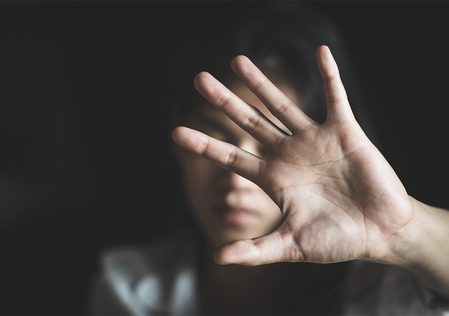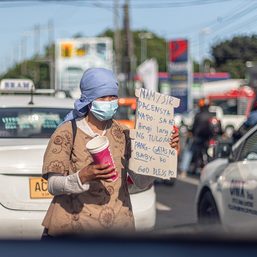SUMMARY
This is AI generated summarization, which may have errors. For context, always refer to the full article.

MANILA, Philippines – The Philippine National Police reported over 8,000 cases of violence against women in 2021, and 5,339 in the first half of 2022, although these figures only reflect those who have spoken out.
Abuse can take many forms, according to Eizaleen Fusingan-Lappay, a licensed professional teacher, psychometrician, and psychologist at MindNation.
She said sexual abuses are non-consensual sexual acts, while emotional abuse includes belittling, gaslighting, criticism, name-calling, verbal and emotional manipulation, dismissing, and silent treatment. Physical abuse is when someone uses force that results in injuries.
Lappay said the perpetrators must acknowledge their tendencies and take concrete steps, such as consulting with mental health professionals, to work on their issues.
She said, “It is not enough to promise to change. Change has to be intrinsic, not dependent on another person; otherwise, it will not be for the long-term.”
Beyond skin deep
One man remained unapologetic after he assaulted his wife.
The victim, Lissa (not her real name), said she was pressured to marry her boyfriend because she got pregnant. For five years, she had endured Lito’s jealousy.
As sweethearts, their relationship had been marked by frequent breakups due to his infidelity, and this continued after they tied the knot.
When Lito turned physical and hurt her, she called her mother, who took her and the baby to her house.
Lissa said Lito never apologized, and she subsequently filed for an annulment of their marriage.
Another victim, Karen (not her real name), said she had to endure two years of physical abuse from Kurt beginning when she was just 16. She said it was a vicious cycle of slaps, kicks, punches, cussing, and belittling followed by hugs and kisses, and apologies.
It was only after a summer vacation abroad that Karen realized the relationship was toxic and decided to end it.
When Kurt attacked her in public, Karen confided in her mother and reported the incident to the school’s student affairs office. Only then did he stay away.
“While I was in the relationship, I felt hopeful that he would change, and hopeless that I would ever get out of it,” Karen recounted.
By the numbers
The 2022 Philippine National Demographic and Health Survey revealed that 18% of women aged 15-49 have experienced physical, sexual, or emotional violence from their current or most recent intimate partner.
Of those, 11% of never-married women and 19% of ever-married women have experienced violence. Some 45% of currently divorced, separated, or widowed women and 17% of currently married women have experienced violence, the data showed.
While these numbers are indicative, factors such as shame and secrecy suggest that the actual number may be even higher.
Economic facet
Court Appeals (CA) Associate Justice Victoria Isabel Paredes said domestic abuse is primarily an economic issue, and women in abusive relationships often remain because they have no other options.
The Child Poverty Action Group has found that women in lower-income households are 3.5 times more likely to experience domestic violence.
Paredes, the chairperson of the CA’s 13th Division, said society should have a more open understanding and discourse about single-parent households, removing the stigma surrounding unmarried women with children.
“In some cases, these women have found the strength to escape their abusive husbands and are working to rebuild their lives and regain their independence. We need to be able to support them and provide them with opportunities to succeed,” she said.
Paredes said abused women should know that they are not alone in their struggle, and the law provides necessary protections to help them overcome the cycle of abuse.
One victim used the law to fight back, and get justice.
Rachel (not her real name) met Ryan while she was a medical resident, and he was an intern.
She said she initially found him charming but soon realized he had a temper and was verbally abusive.
An argument turned physical, and Ryan choked Rachel until she passed out. After she regained consciousness, she went straight to the emergency room to document her injuries.
“I realized that I made excuses for his behavior so many times that I felt like it was justifiable for him to hurt me,” she said.
Rachel filed a case and after eight years, Ryan was found guilty and sentenced to prison.
Misconception and support
Philippine Commission on Women Executive Director Kristine Rosary Yuzon-Chaves said there is also victim-blaming and shaming, the misconception that cases of violence against women (VAW) are private matters, and the notion that there are reasons or causes that can justify hitting a woman.
Chaves said VAW has its roots in the belief that women are weak, submissive, and second-class citizens who can be subjected to violence, and men, viewed as strong and macho, can assert dominance and power by abusing their partners.
The Public Attorney’s Office (PAO) and other organizations and offices can provide legal aid.
RA 9262 establishes a procedure that allows the woman’s extended family, including her parents or relatives, and even strangers, to seek a “Protection Order” if they observe that she is experiencing abuse in her relationship.
Such an order prevents the assailant from committing further acts of violence against the woman and helps the woman re-establish her independence.
The protection order covers provisions on custody of children, any financial support that the woman and her children may be entitled to, and even the removal of the abusive husband from the family home, regardless of ownership.
Jean Enriquez, executive director of the Coalition Against Trafficking in Women-Asia Pacific (CATW-AP), said victims of abuse should approach their barangay’s VAW desk, local social welfare agency, or women’s desk at their local police station.
She said they can get in touch with her organization online so that a support group leader can guide or accompany them. – Rappler. com
Mari-An Santos is an Aries Rufo Journalism fellow.
Add a comment
How does this make you feel?

![[OPINION] Unpaid care work by women is a public concern](https://www.rappler.com/tachyon/2024/07/20240725-unpaid-care-work-public-concern.jpg?resize=257%2C257&crop_strategy=attention)
![[DECODED] The Philippines and Brazil have a lot in common. Online toxicity is one.](https://www.rappler.com/tachyon/2024/07/misogyny-tech-carousel-revised-decoded-july-2024.jpg?resize=257%2C257&crop_strategy=attention)


![[OPINION] Why women seek divorce](https://www.rappler.com/tachyon/2024/06/TL-women-seeking-divorce-june-14-2024.jpg?resize=257%2C257&crop_strategy=attention)
There are no comments yet. Add your comment to start the conversation.